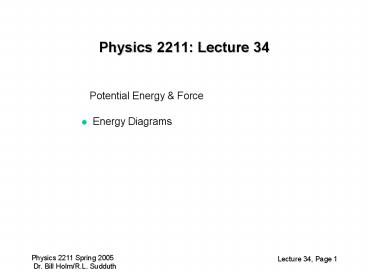Physics 2211 Spring 2005 - PowerPoint PPT Presentation
1 / 24
Title:
Physics 2211 Spring 2005
Description:
classically. forbidden. region. turn around. point. Energy Diagram. K. E. K. Lecture 34, Page 24 ... classically. forbidden. region. classically. forbidden ... – PowerPoint PPT presentation
Number of Views:21
Avg rating:3.0/5.0
Title: Physics 2211 Spring 2005
1
Physics 2211 Lecture 34
- Potential Energy Force
- Energy Diagrams
2
Simple Pendulum
3
The del operator acts on a scalar function
and returns a vector. It is a vector that points
in the physical direction of the greatest rate of
increase in the scalar function. The vector
produced is called the gradient of f.
4
- Example Suppose the air temperature varies as
- In what direction do you move one meter to see
the greatest rise in temperature? - The x-direction
- The y-direction
- The z-direction
- Some other direction
5
(No Transcript)
6
The gradient is the inverse of the line
integral. Are completely equivalent statements.
Either completely defines the relationship
between a conservative force and its related
potential function.
7
Potential Energy Force
- For a conservative force we define the potential
energy function (1D)
- Consider some potential energy functions we know,
and - find the forces
Spring
Gravity (near earth)
Gravity (general)
8
Rather than a graph of Energy vs. Time, it is
often more convenient to make a graph of Energy
vs. Position. This is called an energy diagram.
Example If gravity is the only force present,
the potential energy is
9
The particle is projected upward. The energy is
entirely kinetic
The energy is entirely potential at the turning
point.
The particle has gained potential energy lost
kinetic energy
The particle gains kinetic energy and loses
potential energy
The energy is entirely potential at the turning
point.
10
Potential Energy Diagrams
- Consider a block sliding on a frictionless
surface, attached to an ideal spring.
m
x
U
x
0
11
Turning Points
Total E1
Total E2
12
Here?
Or Here?
Or Here?
13
What kind of motion happens with this potential
energy curve?
Total E
KE
Point of Maximum Speed
Turning Point
PE
14
- The particle never reaches point A
- The particle bounces at point C
- The particle accelerates between D and C
- The particle decelerates between D and C
- The particle moves with constant speed
15
(No Transcript)
16
Equilibrium
- F -dU/dx -slope
- So F 0 if slope 0.
- This is the case at the minimum or maximum of
U(x). - This is called an equilibrium position.
- If we place the block at rest at x 0, it wont
move.
m
x
y
U(x)
x
0
17
Equilibrium
- If small displacements from the equilibrium
position result in a force that tends to move the
system back to its equilibrium position, the
equilibrium is said to be stable. - This is the case if U is a minimum at the
equilibrium position. - In calculus language, the equilibrium is stable
if the curvature (second derivative) is positive.
F
m
x
y
U(x)
F
x
0
18
Equilibrium
U
- Suppose U(x) looked like this
- This has two equilibrium positions, one is
stable ( curvature) and one is unstable (-
curvature). - Think of a small object sliding on the U(x)
surface - If it wants to keep sliding when you give it a
little push, the equilibrium is unstable. - If it returns to the equilibrium position when
you give it a little push, the equilibrium is
stable. - If the curvature is zero (flat line) the
equilibrium is neutral.
unstable
neutral
stable
x
0
19
A Look Ahead
force
force
20
Conservation of Mechanical Energy
- If only conservative forces are present, the
total kinetic plus potential energy of an
isolated system (no external work done on system)
is conserved. -
E K U is constant! or DK
DU 0 - Both K and U can change, but E K U remains
constant.
E K U ?E ?K ?U W ?U W
(-W) 0
using ?K W using ?U -W
21
Potential Energy Diagrams
- Consider a block sliding on a frictionless
surface, attached to an ideal spring. - F -dU/dx -slope
F
x
U
DU
Dx
x
x
0
22
Potential Energy Diagrams
- The potential energy of the block is the same as
that of an object sliding in a frictionless
parabolic bowl - Ug mgy 1/2 kx2 Us
m
y
U(x)
y is the height of an object in the bowl at
position x .
x
0
23
Energy Diagrams
24
Energy Diagrams































